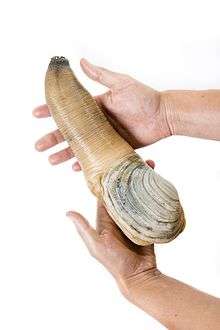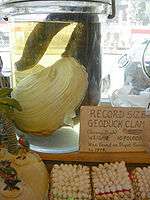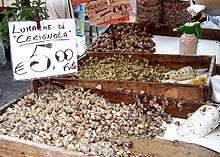Geoduck
The Pacific geoduck (“gooey-duck”; /ˈɡuːiˌdʌk/; Panopea generosa) is a species of very large, edible saltwater clam in the family Hiatellidae.[1][2] The common name is derived from a Lushootseed (Nisqually) word gʷídəq.
| Geoduck | |
|---|---|
 | |
| A live specimen of Panopea generosa | |
| Scientific classification | |
| Kingdom: | Animalia |
| Phylum: | Mollusca |
| Class: | Bivalvia |
| Subclass: | Heterodonta |
| Order: | Adapedonta |
| Family: | Hiatellidae |
| Genus: | Panopea |
| Species: | P. generosa |
| Binomial name | |
| Panopea generosa Gould, 1850 | |
The geoduck is native to the coastal waters of western Canada and the northwest United States. The shell of the clam ranges from 15 cm (6 inches) to over 20 cm (8 inches) in length, but the extremely long siphons make the clam itself much longer than this: the "neck" or siphons alone can be 1 m (3.3 feet) in length. The geoduck is the largest burrowing clam in the world.[3] It is also one of the longest-living animals of any type, with a typical lifespan of 140 years; the oldest has been recorded at 168 years old.[4]
Etymology
The name geoduck is derived from a Lushootseed (Nisqually) word gʷídəq[5][6] either a word composed of a first element of unknown meaning and əq meaning "genitals" (referring to the shape of the clam),[7] or a phrase meaning "dig deep",[8] or perhaps both, as a double entendre. It is sometimes known as a mud duck, king clam or, when translated literally from Chinese, an elephant-trunk clam. A group of geoducks is called a "bag".
Between 1983 and 2010, the scientific name of this clam was confused with that of an extinct clam, Panopea abrupta (Conrad, 1849), in scientific literature.[2]
Biology
Native to the west coast of Canada and the northwest coast of the United States (primarily Washington and British Columbia), these marine bivalve mollusks are the largest burrowing clams in the world, weighing in at an average of 0.68 kg (1.5 pounds) at maturity, but specimens weighing over 6.8 kg (15 pounds) and as much as 2 m (6.6 feet) in length are not unheard of.
A related species, Panopea zelandica, is found in New Zealand and has been harvested commercially since 1989. The largest quantities have come from Golden Bay in the South Island where 100 tonnes were harvested in one year. There is a growing concern over the increase of parasites in the Puget Sound population of geoduck. Whether these microsporidium-like parasitic species were introduced by commercial farming is being studied by Sea Grant. Research to date does indicate their presence.[9]
The oldest recorded specimen was 168 years old, but individuals usually live up to 140 years.[4] A geoduck sucks water containing plankton down through its long siphon, filters this for food and ejects its refuse out through a separate hole in the siphon. Adult geoducks have few natural predators, which may also contribute to their longevity. In Alaska, sea otters and dogfish have proved capable of dislodging geoducks; starfish also attack and feed on the exposed geoduck siphon.
Geoducks are broadcast spawners. A female geoduck produces about 5 billion eggs in her century-long lifespan. However, due to a low rate of recruitment and a high rate of mortality for geoduck eggs, larvae, and post-settled juveniles, populations are slow to rebound.[10] In the Puget Sound, studies indicate that the recovery time for a harvested tract is 39 years.[11]
Biomass densities in Southeast Alaska are estimated by divers, then inflated by twenty percent to account for geoducks not visible at the time of survey.[12] This estimate is used to predict the two percent allowed for commercial harvesting.[12]
Industry
The world's first geoduck fishery was created in 1970, but demand for the half-forgotten clam was low at first due to its texture. As of 2011, these clams sell in China for over US$33/kg or $15 per pound.[13][14]
The geoduck's high market value has created an $80-million industry, with harvesting occurring in the states of Alaska, Washington, and Oregon and the Canadian province of British Columbia. It is one of the most closely regulated fisheries in both countries. In Washington, Department of Natural Resources staff are on the water continually monitoring harvests to ensure revenues are received, and the same is true in Canada where the Underwater Harvesters' Association manages the Canadian Fishery in conjunction with Canada's Department of Fisheries and Oceans. The Washington State Department of Health tests water and flesh to assure clams are not filtering and holding pollutants, an ongoing problem. With the rise in price has come the inevitable problem with poaching, and with it the possibility some could be harvested from unsafe areas.[15]
As of 2007, advances in the testing system for contaminated clams have allowed geoduck harvesters to deliver live clams more consistently. The new testing system determines the viability of clams from tested beds before the harvesters fish the area. Previous methods tested clams after harvest. This advancement has meant that 90 percent of clams were delivered live to market in 2007. In 2001, only 10 percent were live.[16] Because geoduck have a much higher market value live—an additional $4.4 to $6.6/kg or $2 to $3 per pound—this development has helped to stimulate the burgeoning industry.
The COVID-19 pandemic disrupted the geoduck industry. Given the near-shutdown of restaurants and seafood markets across the country, demand for live geoducks plummeted. Divers in Southern Alaska who typically see prices of $5 to $10/lb for live geoducks reported prices as low as $1/lb, leading many to temporarily stop fishing.[17]
- Seafood geoduck display in a Chinese restaurant in Hong Kong
 An ostensibly record-setting geoduck, Ye Olde Curiosity Shop, Seattle, Washington.
An ostensibly record-setting geoduck, Ye Olde Curiosity Shop, Seattle, Washington.
Environmental impact
Geoduck farming grow-out and harvest practices are controversial,[18] and have created conflicts with shoreline property owners,[19][20][21][22] and concerns from nongovernmental organizations.[23] However, the Environmental Defense Fund has found that bivalves (oysters, mussels, and clams) are beneficial to the marine environment.[24] The water must be certifiably clean to plant geoducks commercially.[25] Regulation was mandated in 2007.[26][27] Studies have been funded to determine short- and long-term environmental and genetic impacts.[28] In southern Puget Sound, the effect of geoduck farming on large mobile animals is ambiguous.[29] A 2004 draft biological assessment, commissioned by three of the largest commercial shellfish companies in the Puget Sound region, identified no long-term effects of geoduck farming on threatened or endangered species.[30]
Culinary uses
The large, meaty siphon is prized for its savory flavor and crunchy texture. Geoduck is regarded by some as an aphrodisiac because of its phallic shape.[3] It is very popular in China, where it is considered a delicacy,[3] mostly eaten cooked in a fondue-style Chinese hot pot. In Korean cuisine, geoducks are eaten raw with spicy chili sauce, sautéed, or in soups and stews. In Japan, geoduck is prepared as raw sashimi, dipped in soy sauce and wasabi. On Japanese menus in cheaper sushi restaurants, geoduck is sometimes substituted for Tresus keenae, a species of horse clam, and labeled mirugai or mirukuigai. It is considered to have a texture similar to an ark shell (known in Japanese as akagai). Mirugai is sometimes translated into English as "giant clam", and it is distinguished from himejako sushi, which is made from Tridacna gigas.
Chinese import ban
In December 2013, China imposed a ban on geoduck and other "double-shell aquatic animals"—such as clams, oysters, mussels, and scallops—that were imported from the west coast of the United States. Chinese officials found in an Alaskan shipment high levels of saxitoxin, a natural product that certain shellfish can accumulate, which when eaten by humans, can cause paralytic shellfish poisoning resulting in severe illness or even death. Companies exporting the product claim that Chinese inspectors were using a standard more rigorous than necessary to be considered safe for human consumption. A shipment from Washington state was high in arsenic.[31] The ban was in place for less than 6 months, ending in May 2014.[32]
Popular culture
Evergreen State College in Olympia, Washington has a geoduck named "Speedy" as mascot.[33][34]
References
- Panopea generosa Gould, 1850. Retrieved through: World Register of Marine Species on 28 December 2010.
- Vadopalas, B.; T. W. Pietsch; C. S. Friedman (2010). "The proper name for the geoduck: resurrection of Panopea generosa Gould, 1850, from the synonymy of Panopea abrupta (Conrad, 1849) (Bivalvia: Myoida: Hiatellidae)" (PDF). Malacologia. 52 (1): 169–173. doi:10.4002/040.052.0111. Retrieved 2 March 2012.
- Morgan, James (19 July 2015). "The 'phallic' clam America sells to China". BBC. Retrieved 20 July 2015.
- Orensanz, J. M. L.; Hand, C. M.; Parma, A. M.; Valero, J.; Hilborn, R. (2004). "Precaution in the harvest of Methuselahs clams-the difficulty of getting timely feedback from slow-paced dynamics". Can. J. Fish. Aquat. Sci. 61: 1355–1372.
- "Geoduck". Dictionary.com. Retrieved 29 March 2007.
- "Bartleby.com: Great Books Online -- Quotes, Poems, Novels, Classics and hundreds more". Archived from the original on 5 April 2005.
- Oxford English Dictionary, 3rd edition (March 2012), s.v. "geoduck" (subscription required).
- A. Campbell, R. M. Harbo, and C. M. Hand, "Harvesting and distribution of Pacific Geoduck Clams", Proceedings of the North Pacific Symposium on Invertebrate Stock Assessment and Management (1998), p. 350
- "Geoduck Aquaculture Research Program" (PDF). wsg.washington.edu. Geoduck Aquaculture Research Program, Washington Sea Grant. Retrieved 18 April 2014.
- Georgina Willner. "The Potential Impacts of the Commercial Geoduck (Panope generosa) Hydraulic Harvest Method on Organisms in the Sediment and at the Water-Sediment Interface in Puget Sound", Master's Thesis, The Evergreen State College, Olympia, Washington, June 2006.
- David Palazzi, Lynn Goodwin, Alex Bradbury, Bob Sizemore, Leigh Espy, Susan Sturges, Candis Ladenburg, and Blanch Sabottke. "FINAL Supplemental Environment Impact Statement (S.E.I.S.) for The Puget Sound Commercial Geoduck Fishery", Washington State Department of Natural Resources and Washington State Department of Fish and Wildlife, 23 May 2001. p. 135.
- Rumble, JM; Hebert, KP; Siddon, CE (2012). "Estimating Geoduck Harvest Rate and Show Factors in Southeast Alaska". In: Steller D, Lobel L, eds. Diving for Science 2012. Proceedings of the American Academy of Underwater Sciences 31st Symposium. Retrieved 29 September 2013.
- Vedder, Tracy (3 March 2011). "Chinese mafia rakes in millions from 'Puget Sound gold'". KOMOnews.com. Archived from the original on 6 June 2011. Retrieved 6 March 2011.
- Welch, Craig, 2012. NW geoducks fetch top dollar in China, and as prices soar, so do concerns about illegal harvesting in Puget Sound, The Seattle Times, 22 April 2012, pp 1 & 10.
- Dunagan, Christopher. "Poaching hurts geoduck population growth". Kitsap Sun. Archived from the original on 29 February 2012. Retrieved 5 June 2012.
- Ess, Charlie. "Toxin test gives live market a boost; quota also gets a significant bump". National Fisherman. Archived from the original on 14 November 2006. Retrieved 1 August 2008.
- Stone, Eric; Ketchikan, Alaska's Energy Desk- (18 February 2020). "Coronavirus shutters Southeast Alaska geoduck clam fishery". Alaska Public Media. Retrieved 18 February 2020.
- "Geoduck aquaculture in South Puget Sound" (PDF). Protectourshoreline.org. Retrieved 23 May 2017.
- "Protect Our Shoreline". Protect Our Shoreline. 12 July 2000. Retrieved 5 June 2012.
- "APHETI-Association to Protect Hammersley, Eld and Totten Inlets". Apheti.com. Archived from the original on 29 September 2007. Retrieved 5 June 2012.
- "Responsible Shellfish Farming BC". Responsibleshellfishfarming.ca. Archived from the original on 18 February 2012. Retrieved 5 June 2012.
- "Henderson Bay Shoreline Association". Archived from the original on 28 September 2007. Retrieved 20 May 2017.
- "About the Partnership". Puget Sound Partnership. Archived from the original on 7 May 2009. Retrieved 8 May 2009.
- Goldburg, Rebecca; et al. (2001). "Marine Aquaculture in the United States". Environmental Defense for Pew Oceans Commission.
- "Commercial Shellfish Licensing & Certification Program". Washington State Department of Health Office of Shellfish and Water Protection. Archived from the original on 6 May 2009. Retrieved 8 May 2009.
- "Shellfish Aquaculture Regulatory Committee". Washington State Department of Ecology. Archived from the original on 21 August 2007. Retrieved 10 December 2018.
- "2007 Shellfish Aquaculture Bill, SHB 2220" (PDF).
- "Current Geoduck Research". Washington Sea Grant. Archived from the original on 19 June 2012. Retrieved 5 June 2012.
- Brown, R. A.; Thuesen, E. V. (2011). "Biodiversity of mobile benthic fauna in geoduck (Panopea generosa) aquaculture beds in southern Puget Sound, Washington". Journal of Shellfish Research. 30: 771–776.
- "Programmatic Biological Evaluation" (PDF). Protectourshoreline.org. Retrieved 23 May 2017.
- Coral Garnick (20 December 2013). "State closes geoduck harvest area after China ban". The Seattle Times. Retrieved 21 December 2013.
- Miller, Ben (26 May 2014). "China lifts Washington geoduck ban". Puget Sound Business Journal. American City Business Journals. Retrieved 26 July 2017.
- "Speedy, Evergreen's Geoduck Mascot". evergreen.edu. Retrieved 20 September 2019.
- "10 Weird And Hilarious College Mascots". buzzfeed.com. 11 November 2011. Retrieved 20 September 2019.
2. Evergreen State - The Geoduck
External links
| Wikimedia Commons has media related to Geoduck. |
- Man and Mollusc—Geoduck facts
- Geoduck.org; Underwater Harvester's Association
- Geoduck.org: UHA—BC Seafood Alliance,
- The Evergreen State College's Geoducks Page
- Fisheries and Oceans Canada—Geoduck clam (Panopea abrupta)—Anatomy, Histology, Development, Pathology, Parasites, and Symbionts.
- "Duckumentary" film Home Page: "3 Feet Under—Digging Deep for the Geoduck Clam"
- Geoduck cooking Recipes
